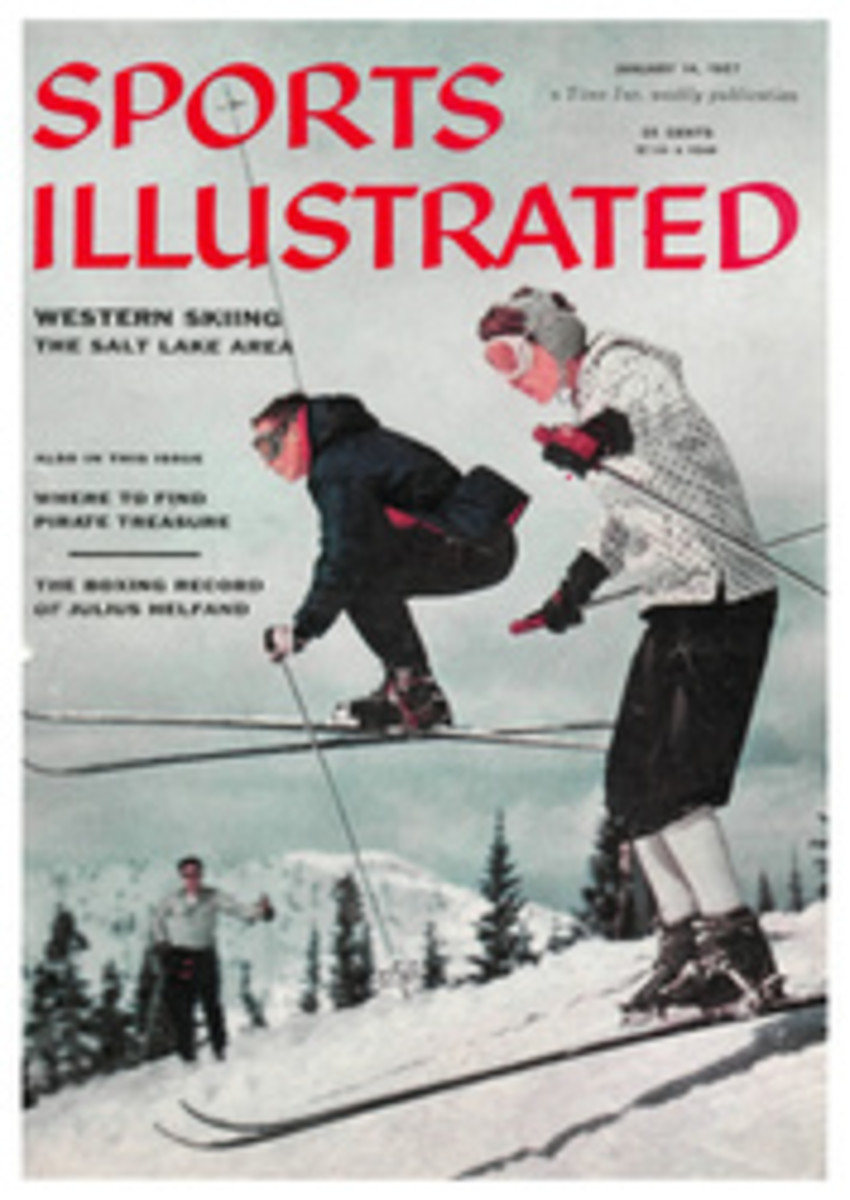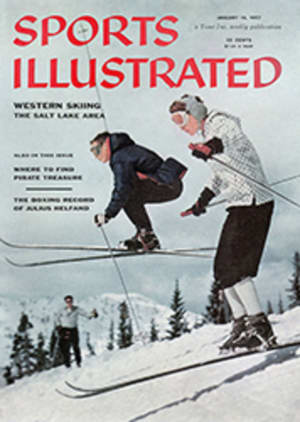
THE FOOTLOOSE SPORTSMAN IN HAVANA
Anyone searching the Caribbean for pirate treasure, as described by Mr. A.B.C. Whipple in the foregoing pages, is likely to pause at some point in Havana, that sunful, sinful nest of dice and daiquiris which lies, like an uninhibited suburb, a scant hour off Miami. What is handy about Havana is that all the elements, including treasure-troves, are virtually at one's elbow.
If, for example, one lives at the venerable Nacional ($27 to $33 for two without meals), one can get tanned around the pool or trimmed in the casino, both of which are hardly a step from the nearest elevator. The pool is surrounded by cabanas and staffed by waiters who will fetch a hamburger from a waterside rotisserie or breakfast from the kitchen. The casino is a castle of craps run by Wilbur Clark—Mr. Clark normally roosts in Las Vegas—and is staffed by croupiers who wear western string ties and may be the most successful treasure hunters on the island. It is just off the lobby. Besides a Vegas playroom, the Nacional is also equipped with a Broadway floor show and a stateside soda fountain. For those who want to be in the same neighborhood but do not feel the need of these appointments, there are places such as the newish Vedado where the daily extraction runs from $18 to $20 for the room without meals. Should one want to plant himself in the local faubourg, the Comodoro is a complete resort hotel, 15 minutes (Cuban-style driving) from downtown. It looks, in a word, like a seagoing concrete cruiser with balconies appended to every stateroom, an open-air pool and cabana club on the aft deck hard by the squash courts. Pulled up as it is-on the midnight blue of the Gulf, hard by an ersatz sandy beach, it could hardly have chosen a better place to dock. The best natural beach is, to be sure, at Varadero, now a half hour away aboard a Cubana Viscount or a pleasant drive in Couture's drive-yourself service ($29 for the round trip).
Just alongside the Nacional Hotel a whole new shopping center called La Rampa has sprouted, sporting a sparkling row of shops that sell perfume (slightly higher than Nassau but lower than the U.S.), laughing crocodiles, Danish porcelain, silver and stainless steel, and a shrunken human head imported from the Amazon ($100).
There has been, as well, an outcropping of lush boîtes in the sector, notably the 21 Club, which stays open until 6 a.m. offering hamburger steaks, Welsh rarebits and other insomnia-inducers while a piano tinkles unobtrusively in the corner. The music is a rousing cascade of violins at Monseigneur, around the corner, which follows the French idea of surrounding the diner with a phalanx of fiddlers on the theory that sauce and strings are the quintessence of good living. No less French is the Vendôme, a restaurant in a private house where the cuisine is Gallic and good, the service is Cuban and the view through the picture windows gives on a tropical arbor.
While the Vedado section is certainly the tony tourist part of town, the frenetic excitement of downtown, with its lottery salesmen, its clanging klaxons, its noisy patrons at the corner zincs, its cacophony ricocheting under the arcaded streets has—believe me—in no way grown tranquil. There is hardly an indoor resort in the whole latitude more inviting than La Florida, which by some enthusiasts has simply been called the best bar in the world. It calls itself variously the Cradle of the Daiquiri and, more sacrosanctly perhaps, the Cathedral of the Daiquiri. Truth to tell, nothing else tastes like a daiquiri after you've had one here, made with cold fresh limes and poured in a long stream, Fitzgerald-era soda jerk fashion. Despite the gilded panels, tieless types do inhabit the bar along with the businessmen, Hemingway and tourists. In the dining room U.S. sirloin is $6.50, Cuban steak $3.50, but vegetables at $1 a dish run up the price. I would skip all that anyway in favor of the Moro crab soufflé at $3.
Just up the block is Sloppy Joe's, which may be démodé but for my money serves the best sandwiches this side of Junior's in Miami Beach. Not far away, at Empedrado No. 207, is an establishment called La Bodeguita del Medio, which translates broadly into The Little Grocery Store in the Middle of the Block. It is indeed just that, but in the back, behind the tins of fish, is a small Bohemian crevice where meals are served. The décor is a pattern of fading photographs of people you never saw before hung over peeling walls. Graffiti cover the otherwise empty wall space, fans spin in the ceiling, a fluorescent tube casts an indigo tinge over the diners, and the cook tickles a bell when dinner's ready. The food is excellent, and the check should not come to more than $3 a person.
As for what to do between dinner and breakfast, Havana offers everything from the Blue Moon to Tropicana. The Blue Moon has a bar, bar girls, a show over the bar that would be banned in Phenix City and private movies upstairs that wouldn't pass the censor if Polly Adler were head of the Johnston office. The Tropicana, just outside town, is an outdoor nightclub roughly the size of Rhode Island, with the audience spread over several acres, lights strung in Jack-and-the-Beanstalk palm trees, and catwalks suspended through jungle. A jumbo-size philharmonic plays for the masses of performers who inhabit the center stage, showgirls hung in the catwalks bump away in bamboo groves in the next county, and all in all the effect is sort of a three-way cross between the Folies-Bergère, the Radio City Music Hall and the Republican convention played in Todd-AO.
In case anybody should be stirring during daylight hours there are cockfights every afternoon except Tuesday and Thursday from one p.m. to 6 p.m., 15 minutes from midtown. Fishermen, if not discouraged by The Old Man and the Sea, can try the same waters for white marlin (early spring), or blue (late spring), as well as the usual assortment of less weighty tropical fish. Call Charles Roca (M-3227), whose boat is berthed in the urban Almendares River. Rate: $50 for five or six hours.
There are no bullfights, the Cubans having adopted béisbol. Four teams, Cienfuegos, Almendares, Habana and Marianao, make up the Cuban League, and among the dozen or more Big Leaguers playing in the rum belt are Sandy Amoros of Brooklyn, Willy Miranda and Tito Francona of Baltimore and Bobby Del Greco of St. Louis. During the game, bookies pass among the crowd shouting the odds, lady hucksters sell chicharrones, rosquillas and fat Cuban cigars. Coffee butchers stroll the aisles carrying Thermoses of rich Cuban ink which is dispensed in paper thimbles. Sitting in a box on the first base line sipping the coffee and puffing a Cuban corona is rather like watching a ball game at the end of a banquet.
ILLUSTRATION
"It's not that he's backward. He's just not interested in school."

